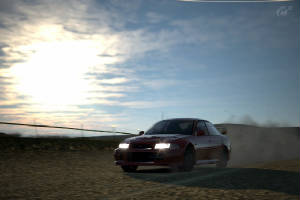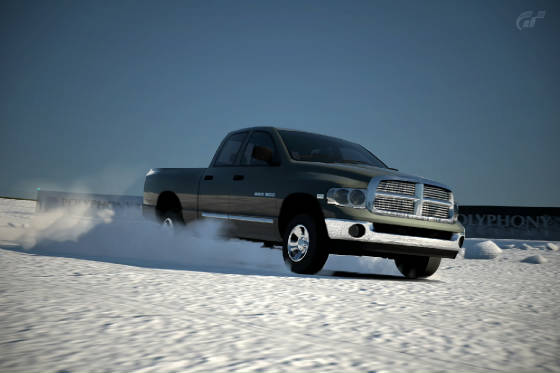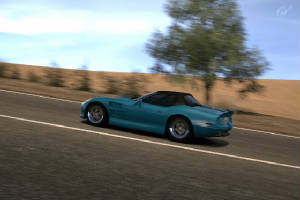|

Intermediate Level
CLUBMAN GRAVEL RALLY
Track: Liege (Gravel)
Horsepower: 345
Maximum Recommended Weight: 2,700 pounds (1,225 kg)
Description
Five stints to accomplish now, rather than three. The competition gets upped, so
that mostly all-wheel drives are participating, and it's best to enter an AWD as well, unless you're really in
need of some challenge!
Again, there are no weight-to-power ratios, but
anything less than 3,000 pounds (1,361 kg) should be used for best results if the competition is easy. Easy grids are
tough to find, though. So when going up against tougher cars (such as those on the top third of the Opponents' list below)
it's best to have weight lower than 2,700 pounds (1,225 kg). Most grids are tougher ones.
For those who never read the before-description, keep in mind that each time a trial
is run, the way the track gets shaped is entirely random. In other words, SS1 is never the same, SS2 is never
the same, and so on. I've figured this out after screwing up multiple times, requiring many restarts.
Because of this, it might seem important to study the map which gets displayed
before the start of each of these, but I have found that a lot of times, these maps are not truthful, and
even if they were accurate it'd be difficult to memorize all those curves and kinks. So bleah, again, I'm cheating.
Relying on that British dude + the GPS map + the brake meter thingie.
The brake meter (Suggested Gear) device is not so reliable at
this set of events. Annoyingly, it signals too late sometimes. So get into the habit of studying the way each turn is shaped
as you're flying toward it.
Again, there is no where to practice for this series. We can make our own off-road course (which can
help with the narrow size of this sort of track), but it'll never be random.
My advice: Do some practice laps around Toscana's Gravel version.
Concentrate on seeing what sort of turn is coming up. Next step is to brake early (sometimes really early), hoping
the car actually turns as the curve approaches. If it seems the understeer will never end, get into the habit of laying
down some power early (mid-turn is optimal), sometimes with full throttle, other times partially. This can help some
cars launch out of turns with some success/less crashes, and a lot of times is better than waiting for the inevitable
*THUD* as the car sideswipes a barrier.
Opponents
'04 Subaru Impreza WRX STi spec C Type
'04 Subaru Impreza WRX STi spec C
'02 Subaru Impreza WRX STi'
'84 Ford RS200
'02 Audi S3
'03 Audi A3 3.2 Quattro
'96 Mitsubishi Lancer Evolution IV GSR
'98 Mitsubishi Lancer Evolution V GSR
'99 Mitsubishi Lancer Evolution VI GSR TMI
'05 Mitsubishi Lancer Evolution IX GSR
'98 Audi S4
'06 Alfa Romeo Brera Sky Window 3.2 JTS Q4
'91 Toyota Celica GT-FOUR RC
'00 Volkswagen New Beetle RSI
'91 Lancia Delta HF Integrale Evoluzione
'04 Volkswagen Bora V6 4MOTION
'02 Toyota Caldina GT-Four
'82 Audi Quattro
'73 Lancia Stratos
'83 Nissan Silvia 240RS
Again those in the top two-thirds of the list: the Audis, the Mitsubishis, the Subarus,
etc., all tend to do better than those at the very bottom third. Anything below the ancient Peugeot 205 is nothing
to worry about, assuming you've brought something suitable.
Parts
Dirt Tires
Full-custom Suspension
Brake Balancer (ABS is optional for older rides)
Single-plate clutch, either flywheel, Carbon
Driveshaft.
Experiments can be tried with limited-slips, center differentials,
and (in the case of Mitsubishis) Advanced Yaw Control to enhance cornering capabilities.
Transmission rated for 160 mph (257 km/h) at the most,
though it's hard to tell what's needed, since each rally stage gets randomized.
Tuning '82
Audi Quattro 5-Speed Close-Ratio Transmission
Center Differential: 50/50
Ride Height: -10/0 Spring Rate: 7.0/6.0 E. Dampers: 3/4 C. Dampers: 3/7 Anti-Roll Bars: 2/4 Camber: 2.5/3.5 Toe: -0.10 / -0.25
Brakes: 5/10
'95 Nissan Skyline GT-R V-spec 6-Speed Super-Close-Ratio Transmission
Center Differential: Standard
F.Differential Initial: 25 Accel: 50 Brake: 5
R. Differential Initial: 5 Accel: 20 Brake: 5
Ride Height: 10/15 Spring Rate: 7.0/5.5 E. Dampers: 2/4 C. Dampers: 4/8 Anti-Roll Bars: 2/3 Camber: 1.5/4.0 Toe: -0.15 / -0.25
Brakes: 4/8
Cars Used
'04 Dodge Ram 1500 (Do not bother trying a truck, it won't work)
'99 Mitsubishi Lancer Evolution GSR
'02 Subaru Impreza WRX STI
--------------------------------------------------------------------------------------------------------------

Alaskan Rally
Track: Alaska
Horsepower: 345
Front-drive Maximum Recommended Weight: 2,500 pounds (1,134 kg)
AWD Maximum Recommended Weight: 3,000 pounds (1,361 kg)
Trucks Max Recommended Weight: 4,000 pounds (1,815 kg)
Description
During the Beginner snow races, marshals decided to hold all trials in the middle of a blizzard. Now
it's nice and sunny. The effect of the sun upon freshly-fallen snow is so bright though.. Where are my sunglasses? As
it turns out, THIS is what'll be the hardest thing about navigating Alaska:. Sometimes it gets pretty tough to simply see
where the track is, and which way those barriers are turning.
As each trial is run, the sun gets lower toward the horizon. None of these are run in full darkness
though (darn). Again, these trials are run randomly, and the Suggested Gear brake indicator
becomes even more unreliable.
But none of that matters. These snowy tryouts are really really easy. During my very
first attempt at SS1, I almost caught up to one of the other cars. I then finished five seconds faster than the second
place Impreza, and this was done with some very lackluster driving. During SS2 I did catch up to that
3rd place car (an '82 Audi) then passed it! By now I was so far ahead of the competition time-wise, I decided to
add ballast to my Lancer Evo. I totally screwed up SS3: spinning fully into a barrier, slamming face-first into another
barrier, finally needing to use reverse.
But like I said, none of this matters. Driving these courses with lots of caution, literally crawling
through some of the trickier hairpins and switchbacks, will pretty much guarantee a win every time. Because the competition
is driving even slower! Here I am, guessing braking zones multiple seconds too hastily, turning in too early, constantly making
safety-net calls too late. This sort of stuff would be really embarrassing on a track I know well, like Tsukuba or Grand
Valley. And it doesn't help that I'm losing my vision due to all that bright snow. Grazing some net barriers. Crashing.
Losing composure, and therefore speed.
....Yet despite all this, I'm still crushing.
During the previous rally at Liege, the driver must find that perfect combination of nerves, caution,
and daring, but must also keep using as much cornering speed as possible. At Alaska,
only caution is needed. Speed and daring become much more secondary. I got to the point that I even tried using
a front-drive Ford Focus. This car culd not just jump off the line like an all-wheel drive, yet managed to win most of its
stages, anywhere from 1.5 to seventeen seconds ahead of the others.
All courses are pretty long too, which is rather fun.
Opponents
All the same as before, minus the rear-drives. Or at least, I have yet to see any of these. Ironically,
rear-drive cars (or even some better front-drives) might be the best choice for some of us.
Note: the rear-drive '73 Lancia Stratos becomes an unexpected sleeper on the snow, blowing many
later-model AWDs away!
Parts
Snow Tires
Brake Balancer
Height-adjustable Sport Suspension (all-wheel drives)
Full-custom suspension (front and rear-drives)
Transmission rated for 150 mph (241 km/h). Fastest I've gone is 164 mph down a "thousand
long" straight, but this only happened once.
Drivetrain parts as needed. Most AWDs won't need any help here, but front or rear-drives can
take limited-slips especially.
Cars Used
''04 Dodge Ram 1500
'03 Ford Focus ST170
'00 Mitsubishi Lancer Evolution VII RS
----------------------------------------------------------------------------------------------------

Tuscany Tarmac Rally
Track: Toscana (Tarmac)
Horsepower: 345
Front-drive Maximum Recommended Wgt: 2,200 pounds (1,000 kg)
AWD and rear-drive Maximum Recommended Weight: 2,700 pounds (1,225 kg)
Maximum Recommended Weight is the very highest I recommend. In reality, it's simply best to make
the car as light as can be, unless it's already below 2,000 pounds, and has stability issues because of this.
Description
Those who thought Polyphony Digital was getting soft will either be disappointed (because they're
not getting soft) or elated (because challenge now returns).
One HUGE factor at this course is sun glare. Almost all of these feature
some sort of blazing light, shining right into our faces, literally blinding the driver. SS1 and SS2 are the worst. Both of
these make the sun's rays into one giant blind spot. Heading into the direction of the sun will guarantee WE CANNOT SEE more
than twenty feet ahead.
One way to combat this is to use one of the different camera views while driving. I'm in the habit
of using in-car view, and I noticed that switching to roof view does help a little.
Thankfully my new favorite cheat device, Suggested Gear. does start working more reliably
again with its brake zone warnings. This is not 100% unfortunately, but I'll say 75 to 80%, it gets 'em right. When
it signals falsely, it usually indicates the driver to brake too early, which is not as bad as too late. Best
of all though, I've noticed it does work pretty well for those over-the-hill blind curves and bends, which is where braking
zones are the hardest to predict.
Different drivetrain types can be used; the driver isn't forced into just AWD like he/she was at the
unpaved trials. I just raced a front-drive Integra for instance, winning 3 out of 5 stages. Keep in mind that those which
haven't got an all-wheel drive's stellar traction off-the-mark will suffer some lost time. So for these cars, search
for some easier grids, if needed.
Another trick I like to employ for those that aren't as good with standing starts: launch
the car in 2nd gear instead of first, especially front-drives. Now that this much power is being played with,
getting a good launch in this gear can sometimes work. Put it in 2nd, rev that engine high, and watch carefully. Some FFs
can handle this sort of power without excessive wheelspin, which means throttle can be pasted down all the way, without fear
of hitting the rev-limiter.
Opponents
Somehow, they all go from being pansies at the snow track to ace professionals again. Oftentimes,
I'll be doing one of these death runs and get lime green time signatures from the stage counters (meaning I am ahead
of the others).. Maybe I'm a second and a half ahead of the others. Next counter, I've got -3.281.
But then it usually falls apart. I'm driving with that mixture of caution
and daring again, trying to squeeze the best racing lines in, and I'm not hitting any barriers. Sometimes getting them
wrong, sometimes getting them right. Somehow though, the others are doing better.
Like all the other more challenging rally events, eventually it's possible to get a feel for
how these courses should get taken. Though the turns, straights, and hills are randomized, the game copy/pastes various
sections together. After awhile, you may notice the same gentle right which merges into that sharp left has been repeated.
The same double right with a short straight in its middle shows up.
It also helps to keep certain cars away from the grid. By now, if the '04 Subaru Impreza Spec WRX
STI C shows, up, that's an automatic reload! The '73 Lancia Stratos also keeps its sleeper
thing going, becoming even more dangerous now that it's back on pavement.
Parts
Soft Sport Tires
Super Soft Sport tires can also be equipped via hybrid programs, for those cars which are really
having troubles with handling. Some cars in the series (such as the Lancia Delta) use these tires.
Brake Balancer
Height-adjustable Suspension (all-wheel drives and some rear-drives)
Full-custom Suspension (front-drives and some rear-drives)
Transmission rated for 150 mph
Single-plate Clutch, either Flywheel, Carbon Driveshaft, and any
additional devices necessary. All-wheel drives shouldn't be needing limited-slips, but some with other drivetrain types might.
Cars Used
'03 Honda Integra Type R
'99 Mitsubishi Lancer Evolution VI GSR TMI
'03 Shelby Series 1 Super Charged
'02 Subaru Impreza WRX STI
|

